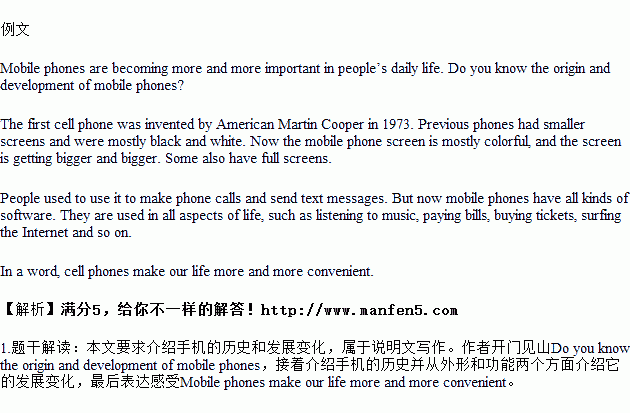题目内容
手机正改变着人们的联系、娱乐和出行等方式。你知道手机的起源和发展吗?请根据下面表格的提示信息,结合手机的发展情况、外形、用途等方面,谈谈它的变化与发展。
要求:
(1)80 词左右(开头已给出,不计入总词数);
(2)可适当增加细节,以使行文连贯;
(3)短文中不得出现你的真实姓名、学校名和地名。
第一部手机由美国人 Martin Cooper 发明于 1973 年。 |
外形特点;以前的手机屏幕较小并且多为黑白屏幕;现在的手机屏幕多为彩色,并且屏幕越来 越大,有的还拥有全屏(full screens)等。 |
功能用途:以前一般用于打电话和发短信(text messages)等;现在手机拥有各种软件(apps),被应 |
用于生活的各个方面,如:听音乐、支付、购票、上网等。 |
Mobile phones are becoming more and more important in people’s daily life.
____________________________________________________________________________________________________________________________________________________________________________________________________________________________________________________________________________________________________________________________________________________________________________________________________________________________________________________________________________
Vancouver (温哥华) Winter Youth Program
In the past 55 years, we have helped a big number of students from 143 countries to improve their English skills. If you want to learn English in a new country, why not join in the ELS Winter Youth Camp program in Vancouver, Canada?
The ELS Winter Youth Camp program helps young learners learn about Canadian culture, improve English skills and make friends with young people from around the world. Would you like to join us? Look at the following form!
Age | 13-17 years old |
Date | January 7-February 8, 2019 |
Lessons a week | 25 (From Mon. to Fri.) |
Length of each lesson | 60 minutes |
Students in each class | No more than 15 |
Cost | $ 1,025 per week |
Telephone number | 604-684-9577 |
1.What can students do at the winter camp?
① Build friendship. ② Travel around Canada.
③ Improve English skills. ④ Learn about a different culture.
A.①②④ B.①③④ C.②③④ D.①②④
2.Which of the following is TRUE?
A.Each lesson lasts for one and a half hours.
B.There will be at least 15 students in one class.
C.Students from 143 countries will join in the program this year.
D.We can make a call to get more information about the program.


